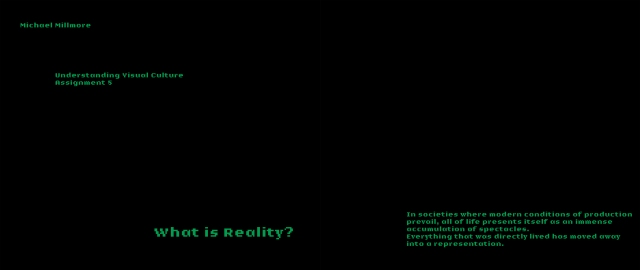

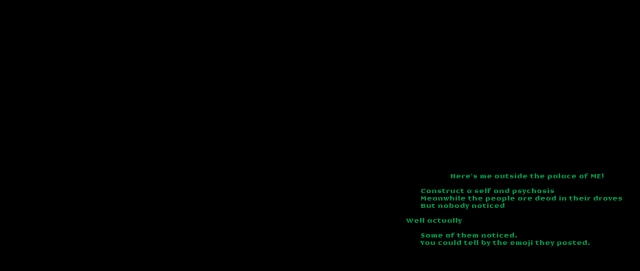



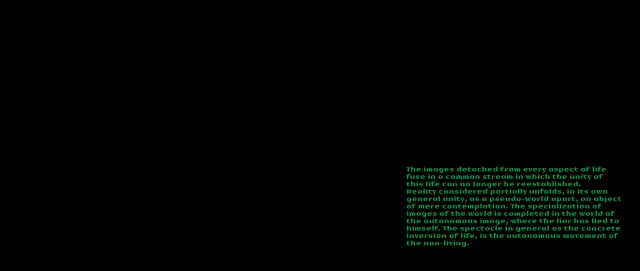
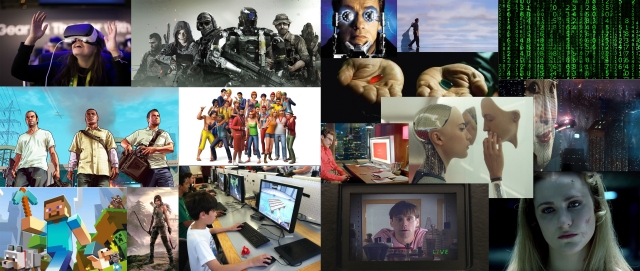
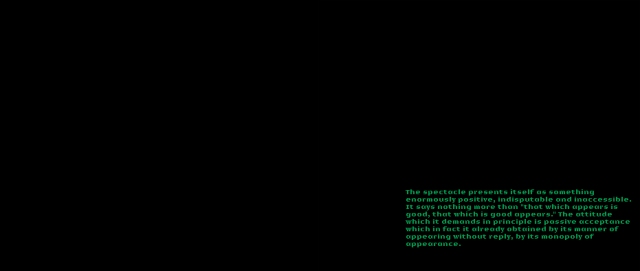

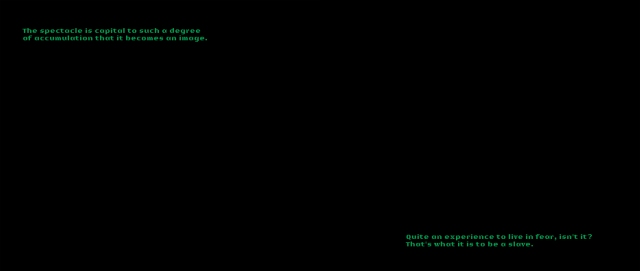
It is a strange paradox that in studying Understanding Visual Culture I have spent little time looking at images with my head stuck mostly in books full of dense writing and few pictures. For this reason I have chosen to produce a visual essay in response to the last assignment for the course. Reading Berger’s Ways of Seeing in one of the early projects I distinctly remember finding it difficult to formulate a response to the visual essays in the book. At first I thought it was because the images are dated, but on further reflection I realised that without the comfort of words to guide my responses I was finding having any sort of response difficult – this was because I was trying to second guess Berger rather than have confidence in my own reading.
Along with wanting to experiment with a different approach for this assignment, and push myself out of my comfort zone at the same time, I also wanted to acknowledge the influence of Debord’s Society of the Spectacle on me during the course. For me the first exercise that requires reading this was a revelation. Taking the advice of the course notes I stuck with the piece, reading and rereading until it began to make sense and eventually I could see elements of what had already been studied falling into place. Debord and the Situationists had real purpose and believed in changing the world through their work. As I move toward the next part of my degree having a purpose for my work is something that I am preoccupied with and I know I will continue to find inspiration and strategies for producing work through what I have studied during this course.
Originally I intended to write about the way technology, and particularly social media, is altering our ability as human beings to engage with each other and even make sense of the real world. Two recent films were an inspiration to me: Hypernoramalisation directed by Adam Curtis (who I have previously discussed in assignment 2) and Lo and behold, reveries of the connected world directed by Werner Herzog. Both films can be described as documentaries but this does not really do justice or accurately describe what they are. Both film makers present an unashamed subjective world view, and while I do not agree with everything they say I admire their assured confidence.
I originally thought about producing a slideshow/film in the spirit of Curtis’ work but decided against this, deciding on a book format – which seems fitting given how important books have been to me throughout the course! A slideshow would mean that the amount of time each page could be viewed would be controlled, instead I wanted the viewer to have the ability to flick between pages and take as much time as needed to study the images. I decided to use quotes from different texts (Society of the Spectacle, Simulacra and Simulation by Baudrillard, a poem by Kate Tempest, the films Blade Runner and Her – I also shortlisted many other quotes from both the course and popular culture that I did not use) as a lead into the images and broad theme setting. One of my favourite photo books is The Nature of Photographs by Stephen Shore and I used this as inspiration. Shore uses short, enigmatic sentences as accompaniments to the photographs he has chosen in the book, with the effect being to kick start the imagination and study the images in way you may not have otherwise. For the images I brainstormed some topics that I felt would fit with the theme of how reality exists in the modern, digital world. They included: Famous people, reality TV, politicians, advertising, business, dead celebrities, scandal, technology, films, news, globalisation, google, facebook, art, commodities and consumerism. I wanted to appropriate images off the internet as the process of doing this would form some sort of curation, I was also interested about what results would come back in my search results. This proved much more difficult than I anticipated and I spent a great deal of time looking for the right images to use. I also did not want any text in the image collages which compounded my difficulties, I wish I had decided that this was the approach I was going to take earlier as collecting images that for the brief over a period of time would have led to better results. I was also shocked by how difficult it was to find pictures I had seen before but could not remember where – for example I recall reading an article about an artist potentially being sued by Donald Trump for producing photoshopped images of him in outrageous situations but could not find the article again.
Stylistically I wanted the text elements of the project to have a retro computer feel and chose a blocky font and green writing reminiscent of an early personal computer. It was important for me that the quotes I chose had no context and I deliberately left off the authors details. For the images I wanted the effect to be haphazard, with the pictures different sizes, overlapping and arranged randomly. The finished effect does not have the effect I envisaged, however, I am not sure how I would change it. If the pictures were the same size and aspect ratio the effect would be too ordered. Perhaps featuring more images slightly smaller would be a better approach however. Each quote has two pages of images in response, the intention is that they would sit next to each other as a double page spread. Each page has a different response to the quote so that the reader can infer further meaning from their juxtaposition. Unfortunately, on exporting to PDF this effect was lost, I will attempt to find a way to rectify and if I cannot will publish as a linear document.
I hesitate at this point to say any more about my image choices as this will influence how meaning is read in the essay. I am unsure if I have managed to fulfil the brief for this assignment but I have enjoyed the process of putting the essay together, albeit that finding the right pictures and preventing repetition has proved to be much more challenging than I had first envisaged.
Bibliography:
Baudrillard, J. (1995) Simulacra and Simulation. Michigan: University of Michigan Press.
Baudrillard, J. (2004) The Gulf War did not Take Place. Sydney: Power Publications.
Berger, J. (1972) Ways of Seeing. London: Penguin.
Blade Runner (1982) Dir: Ridley Scott. USA/Hong Kong/UK: Warner Brothers
Debord, G. (2009) The Society of the Spectacle. Eastbourne: Soul Bay Press
Her (2013) Dir: Spike Jonze. USA: Annapurna Pictures
Hypernormalisation (2016) Dir: Adam Curtis. UK: BBC
Lo and behold, reveries of the connected world (2016) Dir: Werner Herzog. USA: Saville Productions
Shore, S. (2007) The nature of photographs: A Primer. (2nd ed.) New York: Phaidon Press.
Tempest, K. (2016) Let them eat chaos. London: Picador.
